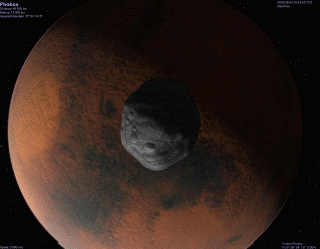
(Note: Published on Blog Critics)
Mars is a world that has captivated the minds of humanity for thousands of years. While it is not known whether or not this world harbors any resources, this rusty world, after the Moon, will probably become humanities first test on whether or not we can survive off world.
But before humanity can conquer the red planet, they need a cost effective way to transport food, passengers and supplies towards its surface. Hosting as well as launching large shuttles on the planets surface may become burdensome and expensive, especially when one considers the effect of red dust upon mechanical devices.
What Martian colonists need is an inexpensive way to transport goods from the surface to space, and what better way could they obtain this than by turning the Martian moons into space stations?
 The Martian moons Phobos and Deimos orbit about 6,000 and 14,500 miles from the surface, respectively, and would lie within easy reach for smaller space craft (especially with Martian gravity being only 38 percent of Earth's).
The Martian moons Phobos and Deimos orbit about 6,000 and 14,500 miles from the surface, respectively, and would lie within easy reach for smaller space craft (especially with Martian gravity being only 38 percent of Earth's).Although launch pads hosting large rockets may look appealing on Earth, they would probably be considered a waste on the red planet. Launch pads hosting large rockets would not only have to be constantly cleaned of the red dust, but be enclosed within a powerful warehouse capable of surviving Martian tornadoes. It would be much easier to host smaller shuttle craft that could "ron de vue" with a larger ship via a space station than launching these massive vessels from the surface.
Despite being composed of carbonaceous rock, the orbital periods of the moons make them prime real estate. Phobos orbits Mars about every 7 1/2 hours while Deimos is just over 30, making them accessible (at least with Phobos) several times a day. If constructed properly, larger ships could simply dock near or inside the asteroids and simply await smaller shuttles to transport the necessary goods or passengers to and from the planet.
 Also the lunar asteroids close proximity towards their parent world would give them a bird's eye view of any storms that may potentially delay a launch or prevent a landing on the crimson planet.
Also the lunar asteroids close proximity towards their parent world would give them a bird's eye view of any storms that may potentially delay a launch or prevent a landing on the crimson planet.Last but not least, by altering the barren asteroids into technological habitats, it would provide a way for Mars to process any metals or minerals harvested from the asteroid belt before being transported to the surface below. This would probably not only reduce costs but also enable them to manufacture stronger materials as well (since it is being done in micro gravity).
After the moon, colonizing Mars will be humanities first taste of conquering another world. But unlike the Moon, future Martian colonists will be unable to depend upon resources in great demand in order to finance their stay on the red planet. Keeping costs down while thriving on Mars will be in the best interests of humanity, and transforming both Phobos as well as Deimos into space stations may aid in that regard.
Want more space geek news? Then subscribe below via email, RSS or twitter for free updates! Prefer another service? How about via RSS or follow Colony Worlds on Twitter!




![ColonyWorlds[at]Gmail[dot]com](http://img.photobucket.com/albums/v438/hiddennook/ColonyWorlds.png)







No comments:
Post a Comment
You can either visit the stars or watch them from afar.
But if you choose the former, you'll definitely get a better view.
~Darnell Clayton, 2007
Note: You do not need a Blogger account in order to comment, but you do need to solve the universal puzzle below.